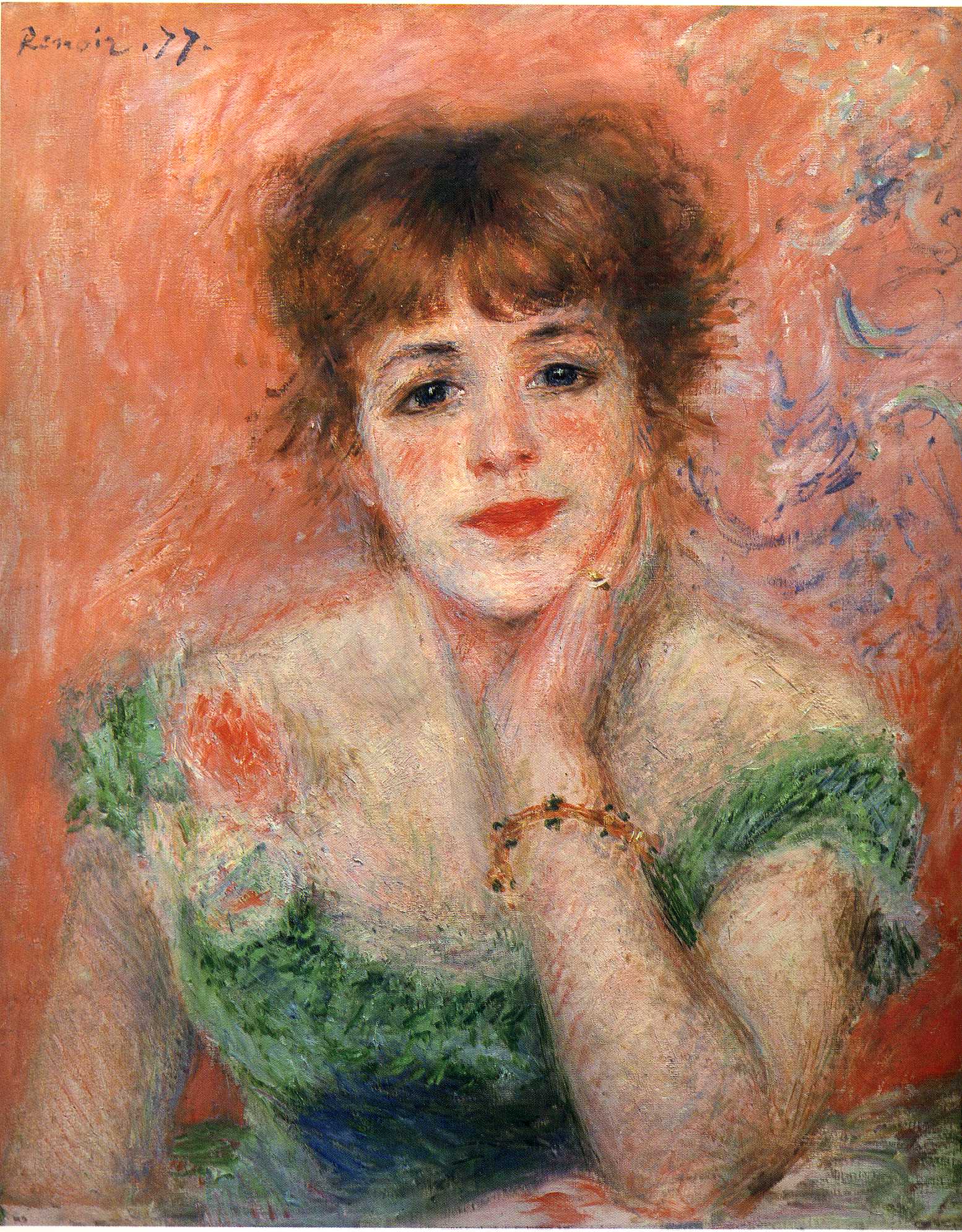art-Renoir.com
Auguste Renoir 1841-1919
Auguste Renoir - Jeanne Samary in a low necked dress 1877
 Jeanne Samary in a low necked dress |
From Christie’s auction house:
Jeanne Samary was one of the most celebrated actresses at the Comédie-Française when she first sat for Renoir in 1877 . Over the next three years, Renoir depicted Samary in no fewer than eight oils and four pastels, more than any other single sitter. She has also been identified as the model for the fashionable young woman in the top right corner of Le déjeuner des canotiers, one of Renoir's most ambitious multi-figure genre paintings (Daulte, no. 379; Dauberville, no. 224; Phillips Collection, Washington, D.C.). Renoir and Samary most likely met at the salon gatherings of the publisher Georges Charpentier and his wife Marguerite, which brought together the leading painters, actors, and writers of the time. The support and influence of the Charpentiers, especially the charismatic Marguerite, were crucial during the late 1870s in establishing Renoir as a successful portraitist to wealthy Parisians. Renoir himself wrote to Georges Charpentier in 1878 or 1879, "If one day I succeed, it will be entirely thanks to her, because I would most certainly have been incapable of doing so on my own" (quoted in Renoir's Portraits: Impressions of an Age, exh. cat., National Gallery of Canada, Ottawa, 1997, p. 161). Although Renoir disliked the acting at the Comédie-Française and rarely attended performances there, he was quite fond of Samary, whose fame in her day rivaled that of Sarah Bernhardt. Georges Rivière recalled that no portrait ever gave Renoir greater satisfaction than the ones he painted of Samary, and the artist himself described her in a letter to Théodore Duret as "la petite Samary, who delights women, but men even more" (quoted in ibid., p. 155). Samary, in turn, lamented, "Renoir is not the marrying kind. He marries all the women he paints, but with his brush" (quoted in N. Wadley, ed., Renoir: A Retrospective, New York, 1987, p. 34).
Jeanne Samary was born in Neuilly-sur-Seine in 1857 into one of France's most celebrated stage families. Her maternal grandmother was Suzanne Brohan, the greatest comédienne of Louis-Philippe's reign, and her aunts Augustine and Madeleine Brohan were two of the most formidable actresses of the Comédie-Française. Samary herself entered the Conservatoire in 1871 when she was just fourteen. She won the first prize for comedy in July 1875 and made her stage debut with the Comédie-Française the following month as Dorinne in Molière's Tartuffe. She excelled at playing saucy, flirtatious serving girls and rose quickly through the ranks of the theater, becoming a full member (sociétaire) of the Comédie-Française in January 1879, two months shy of her twenty-second birthday. In November 1880, at the height of her fame, she married Marie-Joseph Paul Lagarde, the son of a wealthy stockbroker who opposed the match and initiated (unsuccessful) legal proceedings to prevent the wedding from taking place. Just ten years later, Samary succumbed to typhoid fever at the age of thirty-three. More than two thousand mourners, including the staff of all the theaters in Paris, attended her funeral at the Eglise Saint-Roch in Paris.
Renoir first painted Jeanne Samary in early 1877, producing two oil portraits that show her bust-length against a background of flickering, multi-colored brushstrokes. The same year, he also made a pastel portrait of the actress and portrayed her on a pair of plaster medallions (Daulte, nos. 230-231; Dauberville, nos. 461, 463, and 644). In the earlier of the two oil portraits, Samary is dressed simply in a dark blue dress with a white collar buttoned to the neck; the palette of the painting is somber, and Samary's expression is reticent (Daulte, no. 228; Dauberville, no. 460; Comédie-Française, Paris). In the second portrait, by contrast, the actress is clad in a low-cut evening gown with a corsage of roses, her chin propped coquettishly in the palm of her hand . Although Samary was renowned for her boisterous, infectious laugh and the hint of coarseness and vulgarity that she brought to her performances, Renoir chose to depict her as a demure, alluring young woman--the quintessential "star". Colin Bailey has described this version, which Renoir included in the Third Impressionist Exhibition in April 1877, as "resolute and audacious, indeed among the most ravishing of all Renoir's Impressionist portraits... Painted with a parrot-colored palette, it conveys the glamour that we now associate automatically with celebrities of the stage... in a way that no other theatrical portrait of his time succeeds in doing" (exh. cat., op. cit., 1997, p. 158).